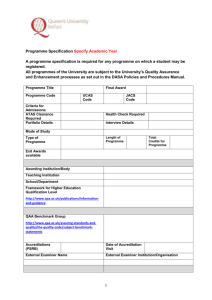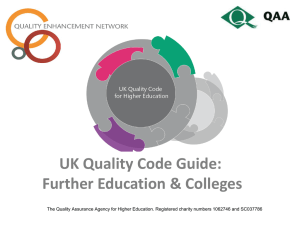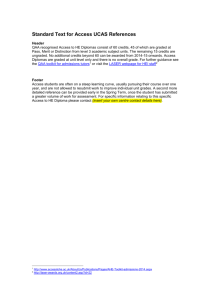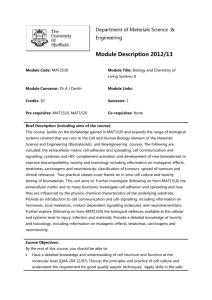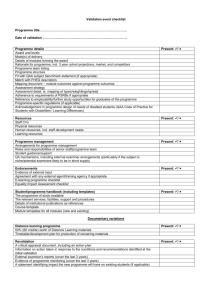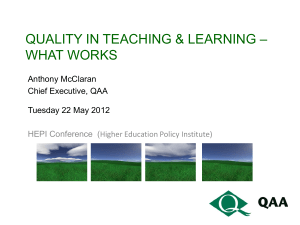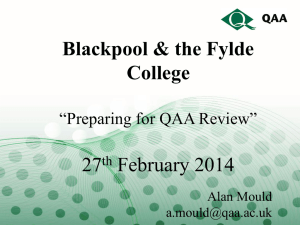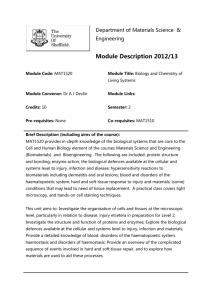Quality Assurance in Higher Education: An
advertisement
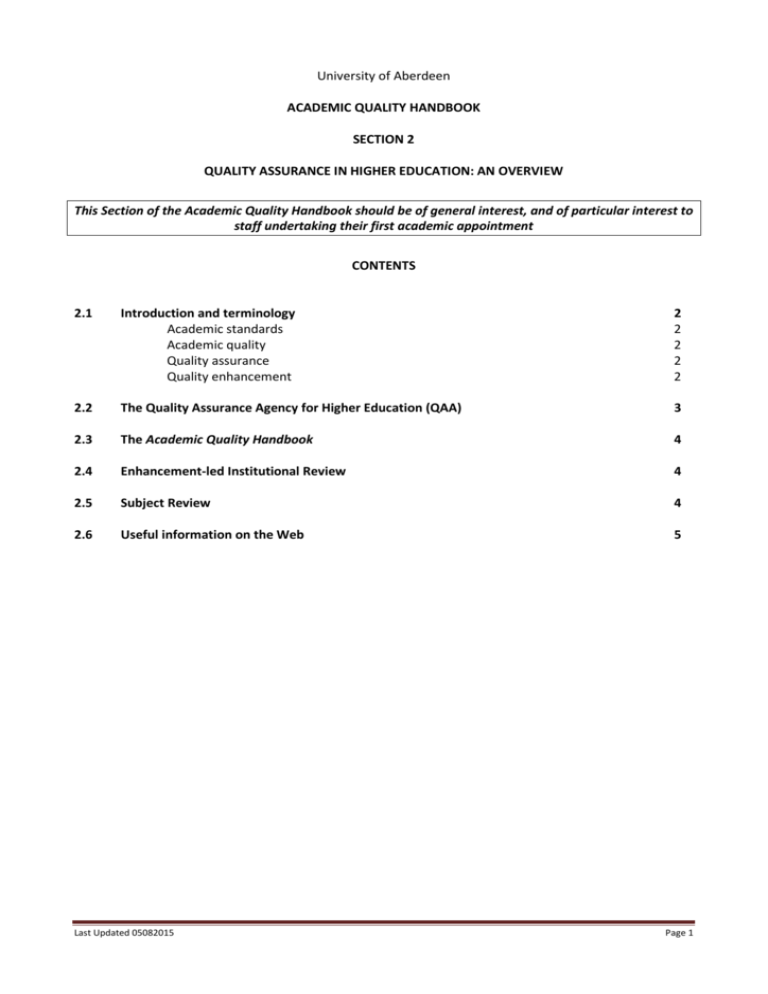
University of Aberdeen ACADEMIC QUALITY HANDBOOK SECTION 2 QUALITY ASSURANCE IN HIGHER EDUCATION: AN OVERVIEW This Section of the Academic Quality Handbook should be of general interest, and of particular interest to staff undertaking their first academic appointment CONTENTS 2.1 Introduction and terminology Academic standards Academic quality Quality assurance Quality enhancement 2 2 2 2 2 2.2 The Quality Assurance Agency for Higher Education (QAA) 3 2.3 The Academic Quality Handbook 4 2.4 Enhancement-led Institutional Review 4 2.5 Subject Review 4 2.6 Useful information on the Web 5 Last Updated 05082015 Page 1 2.1 Introduction and terminology 2.1.1 The University of Aberdeen, as with other institutions of higher education in the UK, must ensure that its educational provision: • • operates with appropriate academic standards; offers students learning opportunities of, at-the-least, acceptable quality. 2.1.2 To ensure that the University meets these requirements, a number of quality assurance procedures operate. Some of these are run by the University itself, whereas others involve external scrutiny. Both internal and external procedures operate according to sector-wide guidance that, in Scotland, is provided by the Scottish Funding Council (SFC), working on behalf of the Scottish Executive. 2.1.3 The key terms are as follows: Threshold academic standards 1 are the minimum level of achievement that you have to reach to succeed on your course and achieve the qualification. A key feature of this is that threshold standards should not vary from one higher education provider to another. Academic quality is how well your higher education provider supports you in your learning: the teaching, the support available, how you are assessed, and the resources available. Quality assurance is the process for checking that the standards and quality of higher education provision meet agreed expectations. 2.1.4 There are various interpretations of what exactly constitutes acceptable quality: e.g., an institution's provision should be "fit for purpose"; should make effective use of resources; should offer its stakeholders value for money; etc… but it is increasingly agreed that it is important to promote improvement of quality, not just to ensure that quality is maintained. This shifts the emphasis from quality assurance to quality enhancement. Quality enhancement 2 (QE) Quality enhancement is taking deliberate steps to bring about improvement in the effectiveness of the learning experiences of students. 2.1.5 1 The core aspects of the student learning experience are: • The learning opportunities the institution provides for its students; • The extent to which the students are engaged with the management of quality and are, therefore, able to act in partnership with the institution in its effective management of the student learning experience. Source: The UK Quality Code for Higher Education: http://www.qaa.ac.uk/assuring-standards-and-quality/the-quality-code 2 Source: Handbook for Enhancement-Led Institutional Review: Scotland (third edition), QAA, 2012 http://www.qaa.ac.uk/reviews-andreports/how-we-review-higher-education/enhancement-led-institutional-review Last Updated 05082015 Page 2 2.2 The Quality Assurance Agency for Higher Education (QAA) 2.2.1 Established in 1997 to replace the Higher Education Quality Council, the Quality Assurance Agency (QAA) 3 is a UK-wide semi-public body that: • • 2.2.2 safeguards educational standards (e.g., it ensures that students awarded a degree in a particular subject have acquired a suitably comprehensive knowledge of that subject, and its related skills, at an appropriate level of sophistication); and promotes the continual enhancement of the quality of teaching, learning opportunities, and related student support services. The QAA is funded by subscriptions from the UK's higher education institutions (HEIs), and by the higher education funding councils, including the Scottish Funding Council (SFC), for whom it performs contract work. The QAA works closely with the higher education sector's 'stakeholders': the funding councils, universities and colleges, staff, students and employers. The QAA acts variously as a think-tank, a spokesperson, and a watchdog. It is responsible for the management of much of what is called the "academic infrastructure" – the guidelines, resources and procedures that both enable and constrain the activities of the UK's higher education institutions. Key elements of this academic infrastructure are the: • • • • The Quality Code for Higher Education 4 Frameworks for higher education qualifications 5 Programme specifications 6 Subject benchmark statements 7 2.2.3 Because higher education in Scotland is separately funded, and has several aspects of policy that are distinctly different to the rest of the UK, the QAA has a separate Scottish Office. This is responsible, in conjunction with SFC, for administration of the new procedures for assurance of standards and enhancement of quality: the Quality Enhancement Framework. 2.2.4 The Quality Enhancement Framework provides the backdrop to the approach taken to quality in the Scottish higher education sector. The Strategy has five main elements: • • • • • a comprehensive programme of subject reviews that are run by institutions themselves Enhancement-Led Institutional Review (ELIR) which involves all Scottish higher education institutions over a five-year cycle public information about quality, intended to meet the needs of a range of stakeholders student engagement in institutional quality systems a national programme of enhancement themes www.qaa.ac.uk http://www.qaa.ac.uk/assuring-standards-and-quality/the-quality-code 5 See www.SCQF.org.uk for details of the Scottish Credit and Qualifications Framework 6 http://www.qaa.ac.uk/en/Publications/Documents/Guidelines-for-preparing-programme-specifications.pdf 7 http://www.qaa.ac.uk/assuring-standards-and-quality/the-quality-code/subject-benchmark-statements 3 4 Last Updated 05082015 Page 3 2.3 The Academic Quality Handbook 2.3.1 The Academic Quality Handbook sets out in detail the procedures used by the University of Aberdeen to safeguard academic standards and assure/enhance the quality of the learning opportunities it offers to its students. The various regulations and procedures set out here incorporate best practice guidelines issued by SFC and/or the QAA (in particular, the relevant sections of The Quality Code for Higher Education). The first edition of the Handbook was published in 1997, the second in 2001. In 2005 the University moved to a web-only version of the Handbook to facilitate regular updates taking account of changes in good practice suggested by the HE sector or the University's own QA/QE procedures. 2.3.2 The Handbook addresses the quality of teaching and learning. It does not cover the quality of research directly, but it does detail procedures that promote the quality of the University's arrangements for the training and supervision of research students. 2.3.3 The Handbook provides the authoritative guide to the University's quality procedures. 2.4 Enhancement-led Institutional Review 2.4.1 SHEFC (now SFC) introduced the Quality Enhancement Framework in 2003 (see Section 3.6), which included new procedures for Enhancement-Led Institutional Review (ELIR). Further enhancements were made to the process for the start of the second round of ELIR in 2008 and for the start of the third round of ELIR in 2012. 2.4.2 The University of Aberdeen underwent ELIR in Spring 2005, Spring 2010 and Autumn 2013. In the 2013 review, the ELIR Panel’s overarching judgement concluded that ‘The University of Aberdeen has effective arrangements for managing academic standards and the student learning experience. These arrangements are likely to continue to be effective in the future’. All details pertaining to ELIR can be found at www.abdn.ac.uk/elir. 2.5 Subject Review 2.5.1 The introduction of the Quality Enhancement Framework in 2003 gave institutions responsibility for conducting a comprehensive programme of subject review. In doing so, the SFC recognised that Scottish HEIs had put in place robust procedures for assuring quality and standards of their provision and could be given ownership for the continuation of such procedures without the need for annual, external subject review. At the University of Aberdeen, the Internal Teaching Review procedures are aligned with the SFC guidance. 2.5.2 Details of the University’s Internal Teaching Review procedures are given in Section 3. Last Updated 05082015 Page 4 2.6 Useful information on the Web About the Quality Assurance Agency for Higher Education Academic Standards and Quality Enhancement-Led Institutional Review: Scotland Quality and Standards in UK Universities: A guide to how the system works General Publications: www.qaa.ac.uk/AboutUs/Pages/default.aspx www.qaa.ac.uk/AssuringStandardsAndQuality/Pages/default .aspx www.qaa.ac.uk/InstitutionReports/types-ofreview/Pages/ELIR.aspx www.universitiesuk.ac.uk/highereducation/Pages/QualitySta ndardsGuide.aspx Past quality review reports, institution level: University of Aberdeen, Enhancementwww.abdn.ac.uk/elir/ Led Institutional Reflective Analysis (2005, 2010 & 2013) www.qaa.ac.uk/InstitutionReports/Reports/Pages/ELIRUniversity-of-Aberdeen-10.aspx ELIR 2005, 2010 & 2013 outcome www.qaa.ac.uk/InstitutionReports/Pages/University-ofAberdeen.aspx Past quality review reports, subject level: UoA Internal Teaching Review (2003 www.abdn.ac.uk/staffnet/teaching/internal-teaching-reviewonwards) 843.php Last Updated 05082015 Page 5
